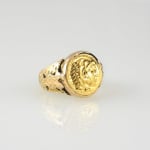Gold Ring Featuring a Gold Coin of Alexander the Great, 18th Century CE - 19th Century CE
Gold
FJ.7176
Further images
Both the gold setting and the gold coin date to the Classical Revival period, evoking the ancient style. Alexander the Great, son of Philip II of Macedon, is arguably the...
Both the gold setting and the gold coin date to the Classical Revival period, evoking the ancient style.
Alexander the Great, son of Philip II of Macedon, is arguably the most important historical figure in the ancient world. Born on July 20th, 356 BC, he was an astute, if somewhat headstrong student, and was schooled by various famous teachers, notably Aristotle. By the time of his death at the age of 32, he had personally supervised one of the largest land-based military expeditions of all time, and had conquered the whole of the then known world from Asia Minor across the whole of Persia, Anatolia, Syria, Phoenicia, Judea, Gaza, Egypt, Mesopotamia, Bactria, parts of India, Afghanistan and Pakistan. A legend in his own lifetime, he became known as much for his excesses and cruelty as his extraordinary military prowess but was nonetheless a comparatively fair and temperate man. Perhaps due to his supposed descent from Achilles and Herakles, he essentially became deified during the Hellenistic period. The Greeks celebrated Alexander in art and song, and his legend continued under the Romans, who had a fascination with military campaigns and tactics.
Alexander the Great, son of Philip II of Macedon, is arguably the most important historical figure in the ancient world. Born on July 20th, 356 BC, he was an astute, if somewhat headstrong student, and was schooled by various famous teachers, notably Aristotle. By the time of his death at the age of 32, he had personally supervised one of the largest land-based military expeditions of all time, and had conquered the whole of the then known world from Asia Minor across the whole of Persia, Anatolia, Syria, Phoenicia, Judea, Gaza, Egypt, Mesopotamia, Bactria, parts of India, Afghanistan and Pakistan. A legend in his own lifetime, he became known as much for his excesses and cruelty as his extraordinary military prowess but was nonetheless a comparatively fair and temperate man. Perhaps due to his supposed descent from Achilles and Herakles, he essentially became deified during the Hellenistic period. The Greeks celebrated Alexander in art and song, and his legend continued under the Romans, who had a fascination with military campaigns and tactics.





